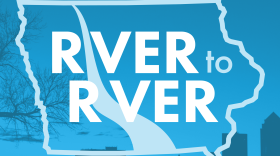More than half of the freezers at Care and Share Pantry in Council Bluffs are empty.
They’d usually be filled with meat, but director Carol Thein said it’s been harder to get all the protein the organization needs. She said she’s seen a nearly 50% increase in clients from this time last year – topping the levels of demand at the height of the pandemic. Around a fourth of those clients are entirely new.
As inflation drives up the price of food, food pantries across Iowa are seeing an increase in demand for their services. But, it’s coming at a time when many food banks are having trouble keeping their shelves stocked.

“Of course, the food pantries, we're all experiencing increased costs for utilities, and to rent the truck to get food and pay for the gas,” she said. “So that's just fewer dollars available to purchase food. But, we're not going to let that stop us.”
As pandemic aid ends, the U.S. Department of Agriculture (USDA) has decreased the amount of food it provides Feeding America’s Food Banks. The organization’s food banks experienced a 20% decrease in manufacturing donations and a 45% decrease in federal commodities in fiscal year 2022.
At the same time, Iowans who qualify for Supplemental Nutrition Assistance Program (SNAP) benefits are no longer receiving extra aid tied to pandemic assistance. The change in April meant $95 a month less for around 140,000 Iowa households.
In May, inflation hit 8.6% – the highest level since the winter of 1981. Food costs surged, with 14% increases in the prices of meats, poultry, fish and eggs.
All of which are contributing to longer lines and new faces at food pantries across the state, said CEO of Food Bank of Iowa Michelle Book.
“Because the federal and state government believe we're back to normal doesn't make it so,” Book said. “We are not back to normal. The effects of COVID for those folks living out around poverty will linger for years.”

On top of that, many organizations are seeing fewer food donations. To fill the gap, food banks have to purchase more food. Book said the Food Bank of Iowa is spending ten times more on food than they did in 2019. In addition, the organization is paying nearly double to transport food to its 700 partner agencies across 55 counties in Iowa.
Food Bank of Siouxland executive director Jacob Wanderscheid said the western Iowa food bank is spending 15% more on food than an average year. The result is a limitation on how many people food banks can serve.
“We just can't serve as many end-users,” he said. “So, the guests at the food pantries may see less in the basket that they receive, and we may not necessarily be able to stay open for the full time that we're advertising for a pantry window.”
“We are not back to normal. The effects of COVID for those folks living out around poverty will linger for years.”Michelle Book, CEO of Food Bank of Iowa
In her decade of experience at the Council Bluffs food pantry, Thein said she’s never experienced such a lack of availability of food. She said, in the past, she used to scroll through 20 to 30 pages of food options on the USDA website.
“The last two months, when I go to get on the website, there might be eight to 10 items,” she said. “And in the last two weeks, when I get on there have been two to three items on the webpage.”
It leaves Thein questioning if Care and Share Pantry should pare back on the food they give away daily. She said she doesn’t want to scale back, but she wants to make sure their shelves can stay stocked in the long-term.
“The level of poverty is just more visible to all of us,” Thein said. “It's concerning. It's very concerning.”





